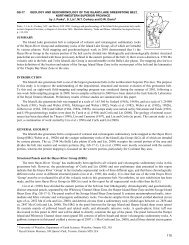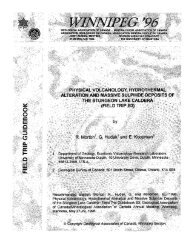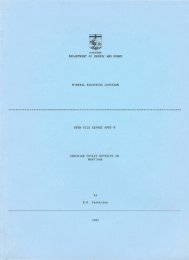Guideline for Stack Sampling Facilities
Guideline for Stack Sampling Facilities
Guideline for Stack Sampling Facilities
Create successful ePaper yourself
Turn your PDF publications into a flip-book with our unique Google optimized e-Paper software.
<strong>Guideline</strong>s <strong>for</strong> <strong>Stack</strong> <strong>Sampling</strong> <strong>Facilities</strong>, Version 1.0<br />
Manitoba Department of Environment<br />
Page –2-<br />
2. <strong>Sampling</strong> ports:<br />
a) Ports should normally be made from standard industrial pipe but stainless steel or other<br />
non corroding material should be used where corrosion problems might exist;<br />
b) The inside diameter of all ports should be at least 3 1/2 inches and should extend<br />
outwards from the exterior stack wall a distance of 3 inches. Ports should be flush with<br />
the interior stack wall. Note that some methods, such as EPA Method 201 or 201A,<br />
require a 6 inch diameter port. The proponent should verify the port diameter<br />
requirements pursuant to the applicable method be<strong>for</strong>e installing ports;<br />
c) Ports should be threaded to accommodate screw on caps which should be installed at<br />
the time of port installation. The port caps should be installed whenever the ports are not<br />
in use.<br />
3. Sample port location:<br />
a) Where possible, sample ports should be located at any section of the stack which is eight<br />
or more stack diameters (distance) downstream and two or more stack diameters<br />
(distance) upstream from any flow disturbance such as a bend, constriction, expansion<br />
or stack exit;<br />
Under some circumstances, ports may be located at distances less than the 8 and 2<br />
stack diameters mentioned above, but not less than 4 and 1 stack diameters respectively.<br />
The proponent should note that all stack sampling methods require laminar flow, i.e., no<br />
cyclonic or reverse flow or stratification pattern. Although locating ports at 8 and 2 stack<br />
diameters respectively from a flow disturbance does not guarantee laminar flow,<br />
decreasing the number of stack diameters increases the chance of flow disturbances that<br />
will negatively impact the sampling location, requiring remedial action to either correct the<br />
flow pattern or relocate the sampling ports, etc.<br />
c) For circular stacks with outside diameters less than 3 metres (10 feet) two ports are<br />
normally installed. Ports are installed at identical elevations and 90 degrees or right<br />
angles to each other;<br />
d) For circular stacks with outside diameters greater than 3 metres (10 feet) four ports are<br />
normally required. Ports are installed at identical elevations and 90 degrees or right<br />
angles to each other;

















